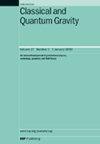顺月空间双向时间传递精度与稳定性研究
IF 3.6
3区 物理与天体物理
Q2 ASTRONOMY & ASTROPHYSICS
引用次数: 0
摘要
星间链路时钟同步与同步的实现对于导航、天基甚长基线干涉测量(VLBI)实验和基础物理精度测试具有重要意义。研究了顺月空间星间链路时频传输的精度和稳定性。建立了微波双单向测距(DOWR)的相对论时间传递模型。以远距离逆行轨道(DRO)-低地球轨道(LEO)卫星间链路为例,实现了亚纳秒级的精度。分析了LEO卫星和DRO卫星的定轨误差。采用相对速度校正、相对论频移和夏皮罗延迟模型,研究了时间传递的稳定性。结果表明,在LEO卫星10 cm和DRO卫星50 m定轨精度约束下,DOWR微波链路支持时钟同步,时间稳定性优于14.3 ps / 1000 s,时间稳定性优于100.5 ps / 1天。如果硬件延迟的较长时间稳定性达到ps级,则可以进一步提高DOWR时间传递链路的性能,以支持频率稳定性超过一天的有源氢脉泽建立的时频尺度分布。我们估计,高性能的ro - leo时间和频率比较可以支持10−6级的引力红移测试和天基VLBI实验,将深空探测器的轨道确定提高一到两个数量级。本文章由计算机程序翻译,如有差异,请以英文原文为准。
Accuracy and stability study of two-way time transfer in Cis-lunar space
The realization of clock synchronization and syntonization via inter-satellite link is of vital importance for navigation, space-based Very Long Baseline Interferometry (VLBI) experiments and precision tests of fundamental physics. We study the accuracy and stability of time and frequency transfer via inter-satellite link in Cis-lunar space. A relativistic time transfer model using microwave dual one-way ranging (DOWR) is developed. Taking the distant retrograde orbit (DRO)-low Earth orbit (LEO) inter-satellite link as an instance, sub-nanoseconds level accuracy is achieved. We analyze the error in orbit determination of LEO satellite and DRO satellite. With the models of relative velocity correction, relativistic frequency shift and Shapiro delay, the stability of time transfer is studied. The result shows the DOWR microwave link would support clock synchronization with a time stability of better than 14.3 ps over 1000 s, better than 100.5 ps over one day, with the accuracy constraints on the orbit determination of the LEO satellite 10 cm and DRO satellite 50 m in position. If the longer time stability of hardware delay reaches ps level, the performance of DOWR time transfer link can be further improved to support the distribution of the time–frequency scale established by an active hydrogen maser with a frequency stability of over one day. We estimated that high-performance DRO-LEO time and frequency comparisons may support the gravitational redshift tests at a 10−6 level and the space-based VLBI experiments to improve the orbit determination of deep-space probes by one to two orders of magnitude.
求助全文
通过发布文献求助,成功后即可免费获取论文全文。
去求助
来源期刊

Classical and Quantum Gravity
物理-天文与天体物理
CiteScore
7.00
自引率
8.60%
发文量
301
审稿时长
2-4 weeks
期刊介绍:
Classical and Quantum Gravity is an established journal for physicists, mathematicians and cosmologists in the fields of gravitation and the theory of spacetime. The journal is now the acknowledged world leader in classical relativity and all areas of quantum gravity.
 求助内容:
求助内容: 应助结果提醒方式:
应助结果提醒方式:


